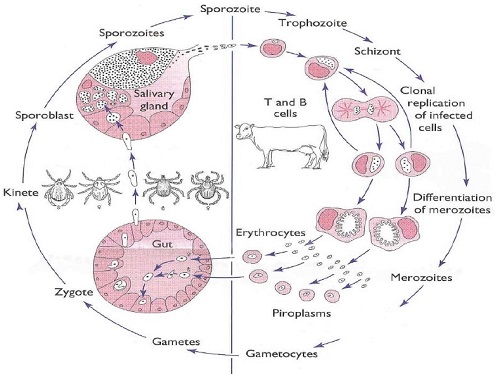Theileriosis in sheep and goat
Introduction
- Mainly two species infect, theileria; Theileria hirci and ovis.
T. hirci (Syn. T. lestoquardi)
Introduction
- These parasite causes malignant theileriosis in sheep and goat.
Morphology
- Trophozoites are found in lymphocytes and erythrocytes as round forms, oval or rod-shaped.
- Binary or quadriple fission takes place in erythrocytes.
- Meronts (Koch bodies), measuring 8 µm in diameter in size and contain 1-80 granules. They are common lymphocytes of spleen and lymph nodes.
Life cycle
- Tick vectors are: Rhicephalus bursa and Hyalomma anatolicum anatolicum.

Pathogenesis
- Disease caused by this species resemble tropical bovine theileriosis.
- Acute form of disease is more common than sub-acute or chronic forms.
- Highly pathogenic and fatal in adult sheep and goat with mortalities of 46-100 %.
Clinical Signs
- In acute form, clinical signs observed are:
- Fever (40-41.7 o C, 104-107 0C)
- Inappetance
- Cessation of rumination
- Rapid heart beat
- Weakness
- Swelling of superficial lymph nodes and eye lids.
- Diarrhea ( Contain blood and mucus)
- Jaundice
- Hemorrhage in sub mucous, sub serous and sub cutaneous tissues may occur
- Affected animals are emaciated and death occurs
- In chronic forms, there is intermittent fever, inappetence, emaciation, anemia and jaundice.
PM findings
- Lymph nodes are swollen
- Enlargement of liver, spleen and lungs become edematous
- Infarcts are present in kidneys
- Petechiae on mucosa of abdomen and irregularly disseminated red patches on intestinal mucosa.
Diagnosis
- Detection of meronts in blood smears. Lymph node biopsies.
- Based on history, clinical signs and PM findings.
Treatment/ Chemoprophylaxis
- Single injection of parvaquone @20 mg /kg body weight intramuscular or buparvaquone @2.5 mg/kg given on two occasions, are effective.
- Single dose of halofuginone @ 1.2 mg/kg orally is also affected.
Prevention and control
- Tick control measures can be considered for controlling disease.
- Topical application of acaricide may provide some level of protection, but is difficult in sheep, expensive and may have negative cost-benefit.